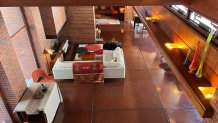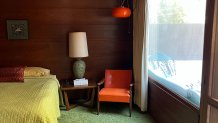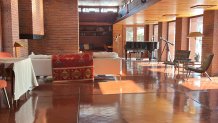Confession: I love midcentury modern architecture.
The lines, the angles, the textures, the windows.
Most of my feeds are riddled with MCM designers and architecture that stands out for its relationship to nature. I spend more time than I'd care to admit scrolling listings and imagining life when many of these timeless homes were built.
It's hard to ignore the man behind much of these designs - renowned architect Frank Lloyd Wright.
Call his style what you will – prairie, usonian, organic, modern – his influence is undeniable even today.
Of course not every lover of midcentury modern can afford to live in a famed FLW home, so when the opportunity arrived to stay at the rentable Still Bend “dream house” in Two Rivers, Wisconsin, my husband and I packed up for a weekend away and drove north about four hours outside of Chicago.
I went to the Still Bend house with what I thought was knowledge of Frank Lloyd Wright and his designs. But even that couldn’t prepare me for experiencing it
Local
It’s not just what you can see that makes the home's design so distinctive, it’s how each space makes you feel. Turns out, that's intentional.
Here’s what I learned during my stay at the historic home:
Feeling out of the loop? We'll catch you up on the Chicago news you need to know. Sign up for the weekly Chicago Catch-Up newsletter.
1. The home will play on all of your senses.
The first thing you notice when you walk through the front door is not the warm woods, the unique patterns in the lights, the low ceilings or even the décor that has you feeling as though you’ve traveled in time.
The first thing you notice is the smell.
Before your eyes have processed what’s unfolding before them, you’re greeted by an almost minty and fresh scent that is perplexing and simultaneously welcoming.
Once you adjust to the cypress fragrance wafting through the air, the architecture takes over and it’s clear where the smell comes from.
The space quickly opens into an expansive living room with floor-to-ceiling windows, soaring cypress-covered ceilings, red brick fireplaces that may look familiar to Chicagoans and burgundy-colored heated concrete floors.

The house changes with the sun. What starts as bright and airy quickly transforms to warm and sultry as night falls.
In the early morning, sunlight dances across the brick in a captivating show that can only be seen if you look at just the right moment.
Staying inside Frank Lloyd Wright’s Still Bend “dream house,” it’s those subtle moments that make it a truly unique experience. And it’s those same subtleties that made co-owner Michael Ditmer want to open the space up for overnight visitors.
“I want people to have a whole new appreciation for the brilliance of Frank Lloyd Wright,” Ditmer said.
See Inside the Frank Lloyd Wright ‘Dream House' Available for Rent in Wisconsin
2. The architecture is designed to physically move you – and it does.
While it may be one of Wright’s quintessential design elements, the ability to force movement in people through architecture is hard to understand until you’re in it.
Enter the home and you’ll quickly feel almost confined by the low ceilings, which sit at just 6 feet, 6 inches. It feels cramped and pinched, even for shorter guests like me, until you realize it’s short-lived and the stories-high ceilings in the living room are just steps away.
“When you walk through the front doors, right away, you know, you're being moved through the house… You want to move through the house to get away from being that uncomfortable under the low ceiling,” Ditmer said. “And then as you walk past the edge of the balcony, the ceiling goes up two floors and it's like you're in a cathedral, at least in my mind, or a sacred space, because you're physiologically, biologically, you feel a sense of freedom and release. And Frank Lloyd Wright did that over and over.”
3. Don’t expect a grand bedroom or bathroom experience.

For those looking to stay in lavish bedrooms and relax in elegant bathrooms, that’s not where this home’s luxury lies.
In fact, according to Ditmer, that’s how Wright wanted it.
Ditmer said Wright designed the home so the living spaces were more alluring than the bedrooms, in an effort to encourage more family time together.
While a larger bedroom can be found on the main level with doors to an enclosed patio, the remaining bedrooms on the upper level are much smaller, with just enough room for a bed and some closet storage.
4. The owners want you to live in the home during your stay and the home will entice you to.
From the moment you step through the front door, it’s as though the house carries you on a journey to its prime.
The colorful, yet somewhat muted, palate adds to the warmth of the wood tones and suddenly you feel as though you’re in a scene from “Mad Men.” The gorgeous fireplace, the smaller of two on the main level, crackles in the background and there’s an unexpected desire to make yourself a cocktail, stand by the piano, put on a Frank Sinatra record and dance across the heated cement below your feet.
In fact, Sinatra is left on the sound system for you upon arrival.
But not everything is in line with the home’s history, per say.
The home was designed by Wright after LIFE Magazine commissioned “dream house” designs in the 1930s.
At the time, the magazine had commissioned designs of a "dream house" for four "typical American families," with incomes ranging from $2,000 to $10,000, according to a website dedicated to the home's history.
"One traditional and one modern architect was assigned to create a house plan for each family," the website states. "Frank Lloyd Wright designed a modern house for the Blackbourn family of Minneapolis who were in the $5,000-$6,000 a year income range. The Blackbourns were taken with Wright’s scheme but ran into a number of obstacles and were unable to build the design."
Eventually, a Two Rivers, Wisconsin, businessman named Bernard Schwartz decided to build the house for his family.
The house was eventually built in 1939, but many of the pieces that now scatter its shelves are not original to the home.
“It's not like a regular house museum where everything is exactly period,” Ditmer said.
Ditmer chose to design the space “so that when you walk through the house, you're on a bit of a time travel trip.”
“Except you're not back in 1939 or 1940 in every place. You'll be singing with Frank Sinatra out in another part of the house because you see the Mad Men cocktail glasses, etc.,” he said.
Vintage board games fill the hidden storage behind the built-in bench seating, persuading you to enjoy a lifestyle vastly different from the world outside those walls.
5. There are many quirks.
While the home is stunning in even the most unexpected ways, there are also some smaller quirks many might not expect.
The main standout is the upstairs bathroom.
Many who attempt to use the facilities available outside the upstairs bedrooms will undoubtedly notice – once and many times going forward – that the bathroom door doesn’t fully open and is blocked by the toilet.
Ditmer said the unexpected error was due to a change in design plans requested by one of the home’s owners, who wanted a linen closet located inside the bathroom, rather than out, letters showed.
The design change likely led to an oversight by Wright, who was not in town at the time, but for the owner, it marked the start of tension in their relationship with Wright as she believed the flaw was intentional.
In addition to the bathroom, for those who have grown used to certain kitchen appliances, it may come as a surprise to find there is no microwave.
But Ditmer said that adds to the time traveling journey.
“We had a microwave in the house for a while … But in keeping with our theme or our mission of giving people the experience of living in the house much as the original owners did, we took the microwave out,” Ditmer said.
6. Much of the home is original, but some big changes are coming.
While keeping the home as close to its original state as possible was crucial to Ditmer’s plans – he considers himself a “steward” of the home rather than the owner – some modifications have been made.
“We didn't compromise on anything as far as what we've done to the house. Again, our ethic is to restore the house to exactly the way it was when it was built,” Ditmer said.
He noted, however, that there have been some modifications made in the past.
The stunning windows that seem almost integral to the home were actually once French doors. The lighting was updated to LED, though Ditmer said he took extra care to make sure it mirrors the lighting that was available at the time the home was built.
And then there’s the kitchen.
“Other than the French doors being replaced with plate glass, the only other part of the house that's been altered was the kitchen,” he said. “The kitchen cabinets had become very worn, and I know the second owner was worried about that. So they replaced those with laminate and it was just reconfigured a little bit to add a dishwasher in the 70s as well. But given our current usage as a vacation rental, if you want to call it that, we've decided not to restore those cabinets back to the original red tidewater cypress that you see throughout the house. Just because the red tidewater cypress is a very soft wood and they would probably get beat up pretty well.”
There are some other renovations coming, Ditmer said, that will bring the home even closer to its former glory.
One of the major changes in store is a plan to restore the French doors, allowing for a summertime breeze and fulfilling Wright’s vision for the home he called a “covered terrace.”

Ditmer also plans to implement Wright’s original landscaping plans.
“We've been working on this project for three or four years,” he said. “We've been working with a local nature center called Woodland Dunes Nature Center and Preserve, and we've been taking out all non-native plants and putting in native plantings per Wright’s specifications. For a lot of the landscaping, in some places he said white pines here and different things, but mostly, he said, native ground cover and native plantings. So because we're in this area, such an important migratory route and one of the most biodiverse parts of the state, we thought we would do our part one to fill Wright's vision, which is very prescient.”
In the future, Ditmer also hopes to build furniture Wright originally designed for the home, but the original owners ultimately gave away.
He also dreams of finally building Wright’s planned additions for the home, which never came to fruition.
“I would really like to at some point down the road build the unbuilt plans that Frank Lloyd Wright produced for this house after visiting this house, which is an elaborate pergola trellis, if you will, going off the back sunken court … out to the river, where he designed a massive two-story boathouse with an entertaining space on the second floor and a balcony open to the river boathouse underneath, and then a beautiful, what he called, farm unit, which would have had a chicken coop, a feed room and a pony stable and little paddock area, all right down on the river,” Ditmer said. “And the chicken coop would have had 13-inch windows, just like you see on the board and battens throughout this house with a metered corner. So those chickens would have had a beautiful view down the river. So really, my ultimate dream is to be able to build that at some point and really complete Frank Lloyd's Frank Lloyd Wright's vision for this entire property.”
7. Winter was beautiful, but summer might be even better.
There is unquestionable beauty in untouched snow covering the grounds of the Still Bend house, flakes falling outside the massive windows as you sit by an open fire, your feet resting on the heated flooring below.

But it’s hard to not imagine summertime here. Enjoying the waterfront property, the multiple patios and the home’s ability to become one with nature.
It’s worth noting, however, that pricing is lower during the off-peak season for those who may want a more affordable adventure.
The historic home, which has garnered much attention over the years, is listed for $595 per night, with a minimum of two-night stays. Rates vary depending on the time of year and number of occupants. During peak and holiday seasons, however, those rates climb.
You can find rental options here.



